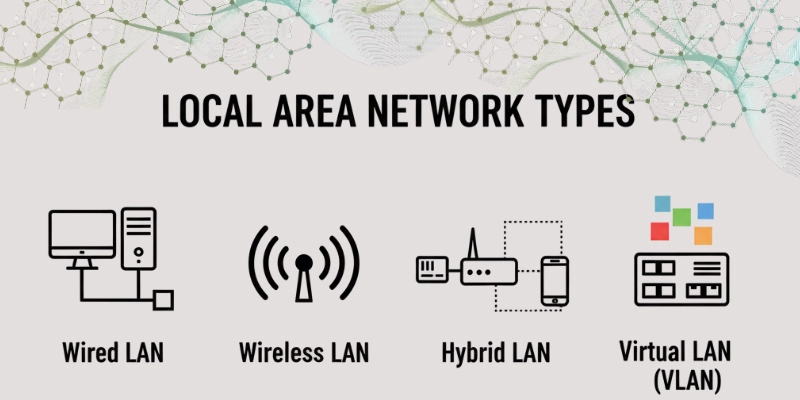Local Area Network (LAN): Types, Components & Benefits
Published: 6 Sep 2025
In today’s connected world, networking has become the backbone of communication and information sharing. One of the most widely used network types is the Local Area Network (LAN), which links computers, servers, and other devices within a limited geographical area such as homes, offices, schools, or campuses.
LANs play a crucial role in enabling fast communication, seamless resource sharing, and internet connectivity within localized environments. From early academic institutions to modern smart workplaces, LANs have evolved into an essential part of everyday digital infrastructure.
In this article, we will discuss LAN in detail and explore its definition, components, types, benefits, and future trends.
What Is a LAN? (Definition & Scope)
A Local Area Network (LAN) is a group of interconnected devices such as computers, printers, and servers that communicate within a confined physical space. Unlike Wide Area Networks (WANs) that span cities or countries, LANs are limited to a building, office, or campus.
LANs provide high-speed, low-latency communication, making them suitable for tasks like file sharing, collaboration, and streaming. They are also a foundation for other networking models, often connecting to larger networks like MANs (Metropolitan Area Networks) and WANs.

How LANs Work: Technologies & Mechanics
The following section provides a clear guide on how LANs work, including the technologies and components that make them function effectively.
1. Connection Methods
LANs can be set up in different ways, and the connection method determines how devices communicate within the network.
- Wired LANs (Ethernet): The most common type, using Ethernet cables and switches to deliver stable, high-speed connectivity. Modern Ethernet supports speeds up to 10 Gbps or more.
- Wireless LANs (WLANs): Based on Wi-Fi standards (IEEE 802.11), these networks allow devices to connect wirelessly, offering flexibility and mobility.
2. Core Components
A Local Area Network is built on several essential components that work together to ensure smooth communication and connectivity.
- End Devices: Computers, printers, smartphones, IoT devices.
- Switches: Connect devices within the LAN and forward data efficiently.
- Routers: Link the LAN to external networks like the internet.
- Access Points: Extend wireless coverage to connect more devices.
3. Topologies & OSI Model Role
LANs may use different topologies such as star, bus, or ring, depending on design requirements. In the OSI model, LANs typically operate at Layer 2 (Data Link) for device-to-device communication, with Layer 3 (Network) involved when connecting outside the LAN.

Types of LANs
The following are the main types of LANs, each designed to meet specific connectivity needs. Understanding these variations helps in choosing the right setup for different environments.
- Wired LAN
- Wireless LAN (WLAN)
- Hybrid LAN
- Virtual LAN (VLAN)
1. Wired LAN
Provides reliable, secure, and high-speed communication via Ethernet cables. Best suited for offices and enterprises where stability is a priority.
- Uses Ethernet cables for consistent and stable connections.
- Offers strong security with minimal interference.
- Delivers high bandwidth, ideal for heavy data transfer.
2. Wireless LAN (WLAN)
Offers mobility and convenience by connecting devices wirelessly. Ideal for homes, cafes, and areas where cabling is impractical.
- Devices connect via Wi-Fi without physical cabling.
- Enables user mobility within the network range.
- Perfect for small offices, homes, and public hotspots.
3. Hybrid LAN
Combines wired and wireless technologies to balance speed, flexibility, and cost.
- Integrates Ethernet for stability and Wi-Fi for mobility.
- Cost-effective while ensuring flexibility.
- Suitable for organizations needing both wired reliability and wireless convenience.
4. Virtual LAN (VLAN)
A VLAN is a logical segmentation of a physical LAN. It improves traffic management, enhances security, and reduces unnecessary broadcast traffic. VLANs are widely used in enterprises to separate departments or services within the same network.
- Segments one physical LAN into multiple logical networks.
- Enhances security by isolating departments or services.
- Reduces unnecessary traffic, improving network efficiency.
Benefits & Use Cases of LAN
The following are the key benefits and use cases of LAN, showing why it remains essential in modern networking. These advantages highlight its role in improving connectivity, efficiency, and collaboration.
- Resource Sharing: Devices can share printers, storage, and applications without duplication.
- High Speed & Low Latency: Ideal for real-time communication, online collaboration, and multiplayer gaming.
- Cost Efficiency: Shared infrastructure reduces the need for duplicate devices and internet connections.
- Security & Control: LANs allow centralized monitoring, access restrictions, and better control over user activity.
- Collaboration: Employees or students can work on shared files and applications with ease.
LAN vs. WAN vs. MAN
Following is a simple breakdown of LAN, WAN, and MAN to help you understand their differences.
- LAN (Local Area Network): Limited to small areas like buildings; high speed, low cost, easy to manage.
- MAN (Metropolitan Area Network): Covers larger areas like cities; connects multiple LANs together.
- WAN (Wide Area Network): Spans across countries or continents; connects multiple MANs and LANs through service providers.
Key takeaway: LANs are designed for localized environments, whereas WANs and MANs connect larger regions.
LAN Challenges & Considerations
While LANs are beneficial, they also come with challenges:
- Scalability: Adding too many devices can create congestion.
- Security Risks: Unauthorized access or VLAN hopping can lead to vulnerabilities.
- Infrastructure Cost: Quality switches, routers, and cabling require upfront investment.
- Management Complexity: Advanced setups like VLANs need skilled IT management.
Future Trends in LAN Technology
Here are some emerging trends in LAN technology that are driving the evolution of networks. These advancements aim to deliver greater speed, intelligence, and security.
- Wi-Fi 6E and Wi-Fi 7: Deliver faster speeds, lower latency, and more capacity.
- Software-Defined Networking (SDN): Allows centralized, automated control of LANs.
- IoT Integration: LANs will continue to support smart devices, sensors, and automation systems.
- Cloud-Based LAN Management: Remote monitoring and configuration via cloud services.
Conclusion
A Local Area Network (LAN) remains one of the most critical parts of modern digital communication. It enables resource sharing, high-speed connectivity, and secure collaboration within homes, offices, schools, and enterprises.
Whether wired, wireless, or virtual, LANs provide the foundation for seamless networking in both personal and professional environments. As technology evolves with Wi-Fi 6, IoT, and SDN, LANs will only become more advanced, reliable, and integral to our connected lives.
💬 We’d love to hear from you! Drop your feedback or questions in the comments ⬇️
FAQs
The following are some frequently asked questions about Local Area Networks (LANs) to help beginners understand the concept more clearly.
A Local Area Network (LAN) is a group of connected devices within a limited area such as a home, office, or school. It allows computers, printers, and other devices to communicate and share resources. LANs are usually fast, reliable, and easy to manage compared to larger networks.
A LAN works by connecting devices through cables (wired) or Wi-Fi (wireless). Switches and routers manage data transfer so that devices can share files, applications, and internet access. This setup ensures smooth and efficient communication within a small area.
The main types are wired LANs, wireless LANs (WLANs), hybrid LANs, and Virtual LANs (VLANs). Wired LANs use cables for stable connections, while WLANs use Wi-Fi for flexibility. VLANs allow logical separation of networks for better security and management.
Key components include end devices (like computers and printers), switches, routers, and access points. Switches connect devices within the LAN, while routers connect the LAN to the internet. Access points help extend wireless coverage.
LANs make it possible to share files, printers, and internet access among multiple devices. They improve efficiency, reduce costs, and allow real-time communication. Without LANs, each device would need its own separate setup.
A LAN covers a small area like a building, a MAN covers a city, and a WAN can span countries or even the globe. LANs offer higher speed and lower cost compared to WANs. Each type serves different purposes based on size and coverage.
LANs provide fast speeds, secure communication, and easy resource sharing. They are cost-effective since multiple devices share the same infrastructure. Businesses and schools rely on LANs for collaboration and productivity.
Common challenges include managing many devices, ensuring security, and handling network congestion. Advanced setups like VLANs can also be complex to configure. However, with proper design and management, these issues can be minimized.
A wired LAN offers more stability, faster speeds, and higher security. A wireless LAN, on the other hand, provides mobility and convenience. The best choice depends on your environment and needs.
LANs are evolving with Wi-Fi 6/7, IoT integration, and software-defined networking. These technologies will make networks faster, smarter, and more secure. The future promises better performance and adaptability for both homes and businesses.

- Be Respectful
- Stay Relevant
- Stay Positive
- True Feedback
- Encourage Discussion
- Avoid Spamming
- No Fake News
- Don't Copy-Paste
- No Personal Attacks

- Be Respectful
- Stay Relevant
- Stay Positive
- True Feedback
- Encourage Discussion
- Avoid Spamming
- No Fake News
- Don't Copy-Paste
- No Personal Attacks





